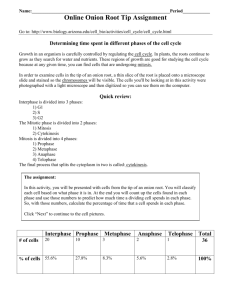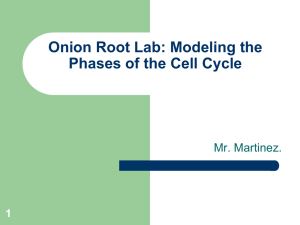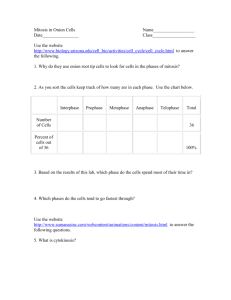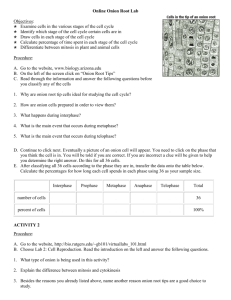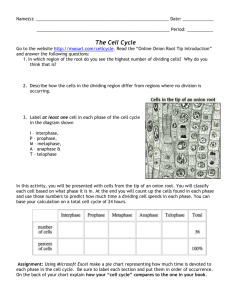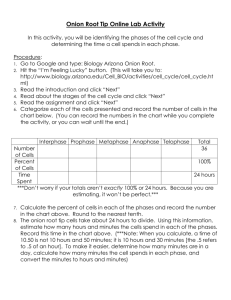Online Mitosis Tutorial
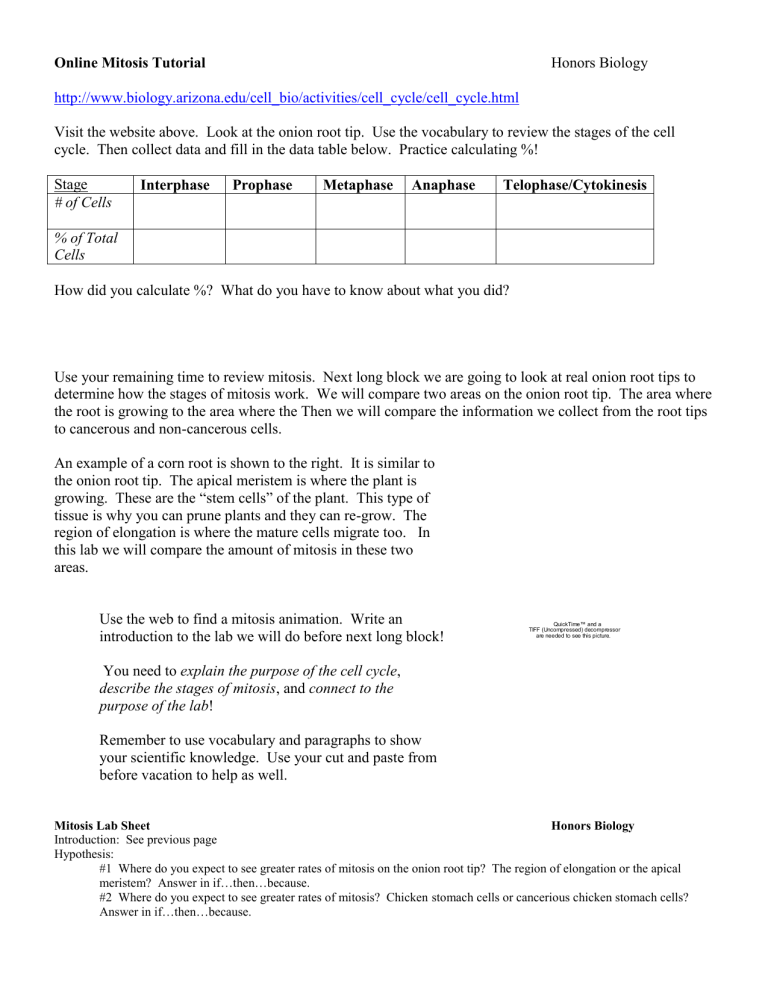
Online Mitosis Tutorial http://www.biology.arizona.edu/cell_bio/activities/cell_cycle/cell_cycle.html
Honors Biology
Visit the website above. Look at the onion root tip. Use the vocabulary to review the stages of the cell cycle. Then collect data and fill in the data table below. Practice calculating %!
Stage
# of Cells
Interphase Prophase Metaphase Anaphase Telophase/Cytokinesis
% of Total
Cells
How did you calculate %? What do you have to know about what you did?
Use your remaining time to review mitosis. Next long block we are going to look at real onion root tips to determine how the stages of mitosis work. We will compare two areas on the onion root tip. The area where the root is growing to the area where the Then we will compare the information we collect from the root tips to cancerous and non-cancerous cells.
An example of a corn root is shown to the right. It is similar to the onion root tip. The apical meristem is where the plant is growing. These are the “stem cells” of the plant. This type of tissue is why you can prune plants and they can re-grow. The region of elongation is where the mature cells migrate too. In this lab we will compare the amount of mitosis in these two areas.
Use the web to find a mitosis animation. Write an introduction to the lab we will do before next long block!
QuickTime™ and a
TIFF (Uncompressed) decompressor are needed to see this picture.
You need to explain the purpose of the cell cycle , describe the stages of mitosis , and connect to the purpose of the lab !
Remember to use vocabulary and paragraphs to show your scientific knowledge. Use your cut and paste from before vacation to help as well.
Mitosis Lab Sheet
Introduction: See previous page
Hypothesis:
Honors Biology
#1 Where do you expect to see greater rates of mitosis on the onion root tip? The region of elongation or the apical meristem? Answer in if…then…because.
#2 Where do you expect to see greater rates of mitosis? Chicken stomach cells or cancerious chicken stomach cells?
Answer in if…then…because.
Methods:
Onion Root Tip
Find the root tip under 4X.
Put the region of elongation in the center of the screen.
Focus under 40X.
Develop a system for determining the stages of the cell cycle you see.
Repeat for the apical meristem region.
Add to class data table.
For your formal lab, identify your independent, dependent, and controlled variables. A table is fine!
Explain how you systematically estimated the total number of cells and determined the appropriate stages.
Describe what calculation was done to the data you collected and the cancer data provided for you.
Data and Analysis:
Onion Root Tip Data
Phase of Cell Cycle Elongation (Individual) Elongation (Class) Meristem (Individual) Meristem (Class)
Interphase
Prophase
Metaphasae
Anaphase
Telophase/Cytokinesis
Total Counted
Data Analysis--% of Cells in Each Phase for individual and class data
Phase of Cell Cycle
Interphase
Prophase
Elongation (Individual) Elongation (Class)
Metaphasae
Anaphase
Telophase/Cytokinesis
Total Counted
Graph—Make a graph to show your analysis and include a written trend!
Previously Counted Chicken Data
Stage of Cell Cycle
Interphase
Prophase
Metaphase
Non-cancerous chicken stomach cells
440
40
8
% of Cell Cycle Noncancerous
Anaphase
Telophase/Cytokinesis
2
10
Meristem (Individual)
Cancerous Chicken stomach cells
424
50
12
3
11
Meristem (Class)
% of Cell Cycle
Cancerous
Total 500 500
Analysis and Graph—Calculate % and create a graph to show the difference between non-cancerous and cancerous tissue! Include a written trend!
Discussion
Paragraph #1:
Respond to hypothesis #1 using a specific piece of data to support or reject the hypothesis.
Make observations about the onion root tip data—what might account for differences in the number of cells in each stage?
Why might this be? Difference in number of cells in the different areas of the root tip.
Use your % to discuss what stage of cell division is the longest and what is the shortest and give the scientific reasoning behind why the stage is either short or long.
Paragraph #2:
Use the chicken data to respond to hypothesis #2.
Explain why this difference might occur using your knowledge of cancer.
How might this be used for diagnosis of cancer?
Extensions. What other human cells might have high % of cells in the stages of mitosis? What human cells might have very little mitosis? Explain your reasoning.
Paragraph #3:
Discuss sources of error in identifying the stages of mitosis. Remember, onion roots are a snapshot in time.
What “training” is required to be able to observe these stages? What did we do to learn?
Why is it inherently (naturally) hard to distinguish between stages—hint: remember this is a cell cycle?
We looked at onion root tips as a model of rapid cell division. How would the onion root tip be similar to a cancerous human tissue? How would it be different? Is it a good model?
